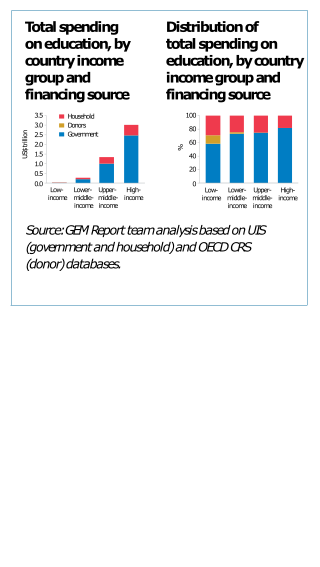
Adult education, distinct from child education, is a practice in which adults engage in systematic and sustained self-educating activities in order to gain new forms of knowledge, skills, attitudes, or values. It can mean any form of learning adults engage in beyond traditional schooling, encompassing basic literacy to personal fulfillment as a lifelong learner. and to ensure the fulfillment of an individual.
Lifelong learning is the "ongoing, voluntary, and self-motivated" pursuit of knowledge for either personal or professional reasons. It is important for an individual's competitiveness and employability, but also enhances social inclusion, active citizenship, and personal development.
International education refers to a dynamic concept that involves a journey or movement of people, minds, or ideas across political and cultural frontiers. It is facilitated by the globalization phenomenon, which increasingly erases the constraints of geography on economic, social, and cultural arrangements. The concept involves a broad range of learning, for example, formal education and informal learning. It could also involve a reorientation of academic outlook such as the pursuit of "worldmindedness" as a goal so that a school or its academic focus is considered international. For example, the National Association of State Universities prescribes the adoption of "proper education" that reflects the full range of international, social, political, cultural, and economic dialogue. International educators are responsible for "designing, managing, and facilitating programs and activities that help participants to appropriately, effectively, and ethically engage in interactions with culturally diverse people and ideas."

Inclusion in education refers to all students being able to access and gain equal opportunities to education and learning. It arose in the context of special education with an individualized education program or 504 plan, and is built on the notion that it is more effective for students with special needs to have the said mixed experience for them to be more successful in social interactions leading to further success in life. The philosophy behind the implementation of the inclusion model does not prioritize, but still provides for the utilization of special classrooms and special schools for the education of students with disabilities. Inclusive education models are brought into force by educational administrators with the intention of moving away from seclusion models of special education to the fullest extent practical, the idea being that it is to the social benefit of general education students and special education students alike, with the more able students serving as peer models and those less able serving as motivation for general education students to learn empathy.
Education in Peru is under the jurisdiction of the Ministry of Education, which oversees formulating, implementing and supervising the national educational policy. According to the Constitution of Peru, education is compulsory and free in public schools for the initial, primary and secondary levels. It is also free in public universities for students who are unable to pay tuition and have an adequate academic performance.
Human development involves studies of the human condition with its core being the capability approach. The inequality adjusted Human Development Index is used as a way of measuring actual progress in human development by the United Nations. It is an alternative approach to a single focus on economic growth, and focused more on social justice, as a way of understanding progress
Content and language integrated learning (CLIL) is an approach for learning content through an additional language, thus teaching both the subject and the language.
The UNESCO Institute for Statistics (UIS) is the statistical office of UNESCO and is the UN depository for cross-nationally comparable statistics on education, science and technology, culture, and communication.
Open educational resources (OER) are learning materials that reside in the public domain or have been released under an intellectual property license that permits their free use and re-purposing by others. OER policies are adopted by governments, institutions or organisations in support of the creation and use of open content, specifically open educational resources (OER), and related open educational practices.

The Roma Education Fund (REF) is a non-governmental organization established within the framework of the Decade of Roma Inclusion by Open Society Foundations and the World Bank in 2005. The organization's goal is to reduce the educational achievement gap between Roma and non-Roma in Europe through the provision of scholarships to Roma students, supporting the development of quality education, and supporting the removal of segregation of Roma students.
Curriculum development is a process of improving the curriculum. Various approaches have been used in developing curricula. Commonly used approaches consist of analysis, design, selectingformation and review.
- Analysis
- Design
- Selecting
- Formation
- Review
Global citizenship education (GCED) is a form of civic learning that involves students' active participation in projects that address global issues of a social, political, economic, or environmental nature. The two main elements of GCE are 'global consciousness'; the moral or ethical aspect of global issues, and 'global competencies', or skills meant to enable learners to participate in changing and developing the world. The promotion of GCE was a response by governments and NGOs to the emergence of supranational institution, regional economic blocs, and the development of information and communications technologies. These have all resulted in the emergence of a more globally oriented and collaborative approach to education. GCE addresses themes such as peace and human rights, intercultural understanding, citizenship education, respect for diversity and tolerance, and inclusiveness.
TVET refers to all forms and levels of education and training which provide knowledge and skills related to occupations in various sectors of economic and social life through formal, non-formal and informal learning methods in both school-based and work-based learning contexts. To achieve its aims and purposes, TVET focuses on the learning and mastery of specialized techniques and the scientific principles underlying those techniques, as well as general knowledge, skills and values.

Action for Climate Empowerment (ACE) is a term adopted by the United Nations Framework Convention on Climate Change (UNFCCC). It refers to Article 6 of the Convention's original text (1992), focusing on six priority areas: education, training, public awareness, public participation, public access to information, and international cooperation on these issues. The implementation of all six areas has been identified as the pivotal factor for everyone to understand and participate in solving the complex challenges presented by climate change. The importance of ACE is reflected in other international frameworks such as the Sustainable Development Goals ; the Global Action Programme for Education for Sustainable Development ; the Aarhus Convention (2011); the Escazú Agreement (2018) and the Bali Guidelines (2010).
Global Reports on Adult Learning and Education (GRALE) are a series of reports that monitor progress on Adult Learning and Education (ALE), promote action, identify trends in the field of ALE, and explore solutions to challenges.
Monitoring Education for Sustainable Development (ESD) refers to measuring progress in ESD learning compared to policy commitments, provision, institutional support, resources and others. Monitoring and evaluation (M&E) of Education for Sustainable Development is widely discussed in literature on ESD, including debates regarding methodology and strategies for interpreting the data.

Large-scale learning assessments (LSLAs) is defined as a form of national or cross-national standardized testing that provide a snapshot of learning achievement for a group of learners in a given year and in a limited number of learning domains.

Sustainable Development Goal 4 is about quality education and is among the 17 Sustainable Development Goals established by the United Nations in September 2015. The full title of SDG 4 is "Ensure inclusive and equitable quality education and promote lifelong learning opportunities for all".
Equity and inclusion in education refers to the principle or policy that provides equal access for all learners to curriculum and programming within an educational setting. Some school boards have policy that includes the terms inclusion and diversity. Equity is a term sometimes confused with equality. Equity and inclusion policy provide a framework for educators and academic administrators that guides training and delivery of instruction and programming. School boards use equity and inclusion principles to promote the use of resources that reflect the diversity of students and their needs. Children have the inherent right to education as determined by the Target 4 Goals of the United Nations. In the past, equity and inclusion referred primarily to students with mental and/or physical challenges that prevented them from learning in regular classrooms. The principle now applies to marginalized students who live with any type of intersectionality based on their social identity. The capabilities approach introduced by Martha Nussbaum and Amartya Sen supports the ideal that each learner should be offered the freedom to choose from the alternative ways they learn and to do it as a shared experience, with the interaction of their peers. It has been shown that schools that are able to implement inclusive and equitable practices tend to be more successful if they have endorsement or support at the regional and national levels of government. Besides the need for infrastructure and resources, cultural attitudes and beliefs strongly influence the creation and sustainability of effective programming in schools.
The learning crisis or global learning crisis is a term describing the fact that, despite a large increase in access to schooling, learning outcomes remain poor, especially in developing countries. Worldwide, millions of children who attend school do not acquire basic skills such as literacy and numeracy, and many more are far behind age-appropriate expectations in their national curricula. Proponents argue that this crisis needs to be addressed due to the importance of education in fostering children's development, social mobility, and subsequent opportunities.





